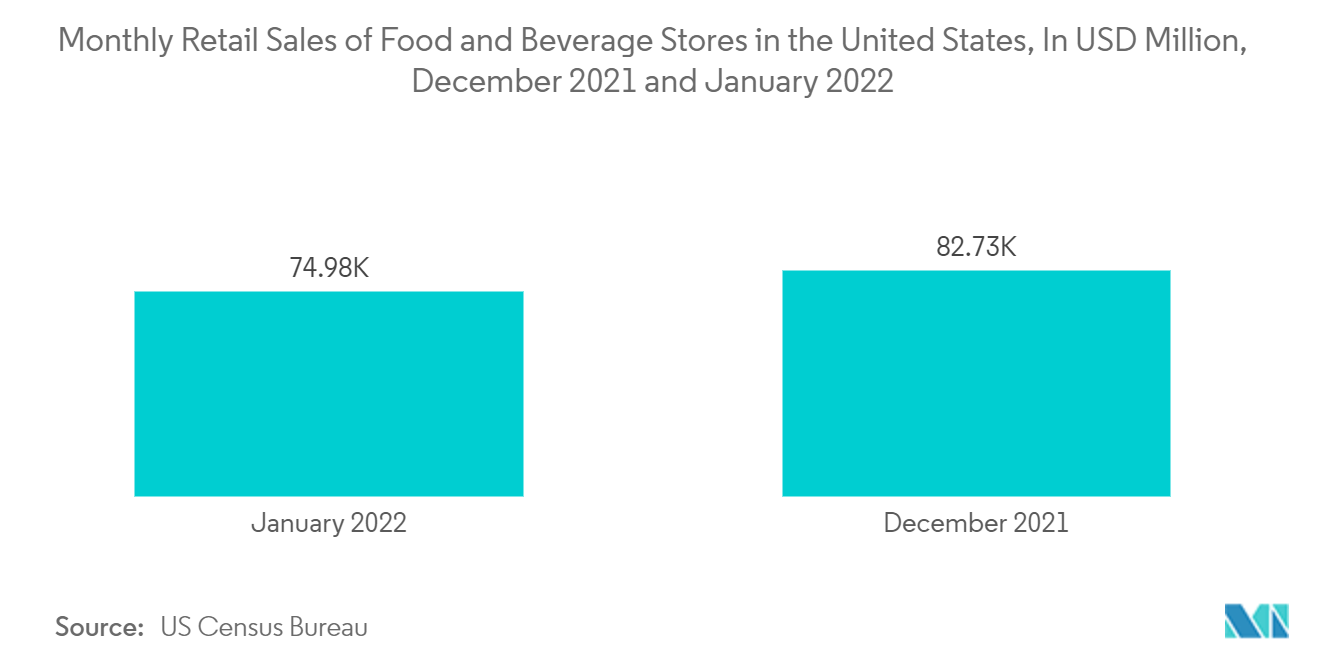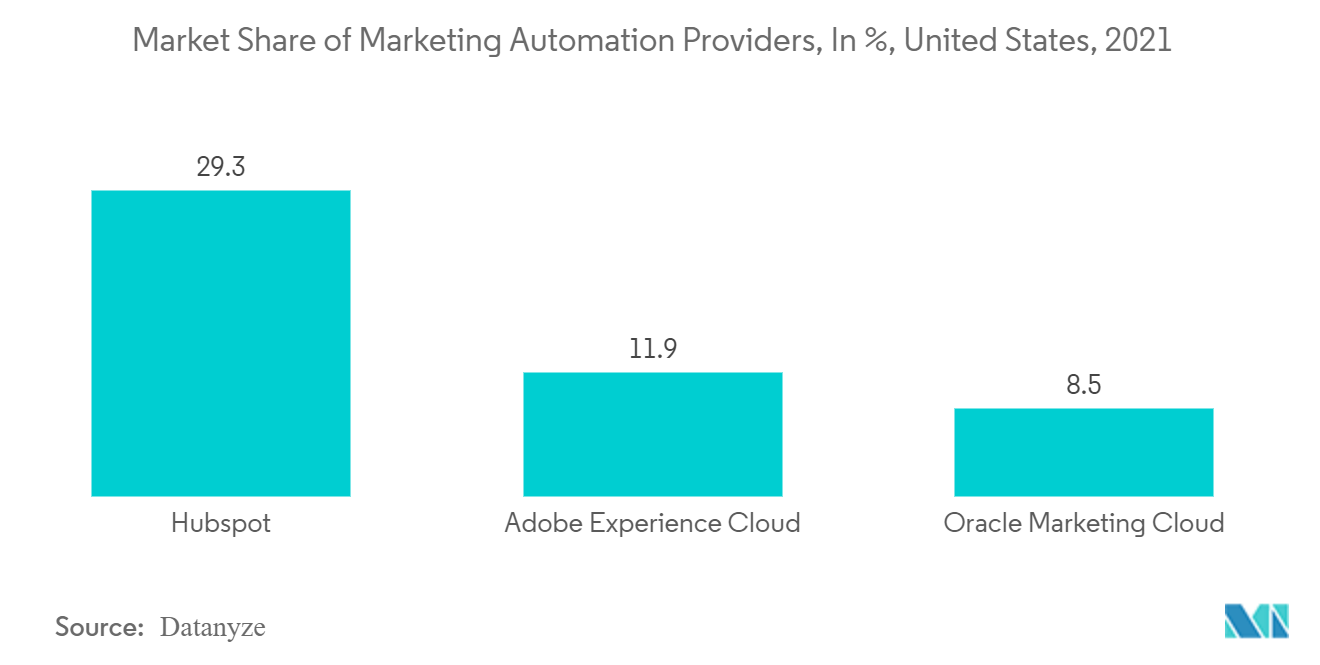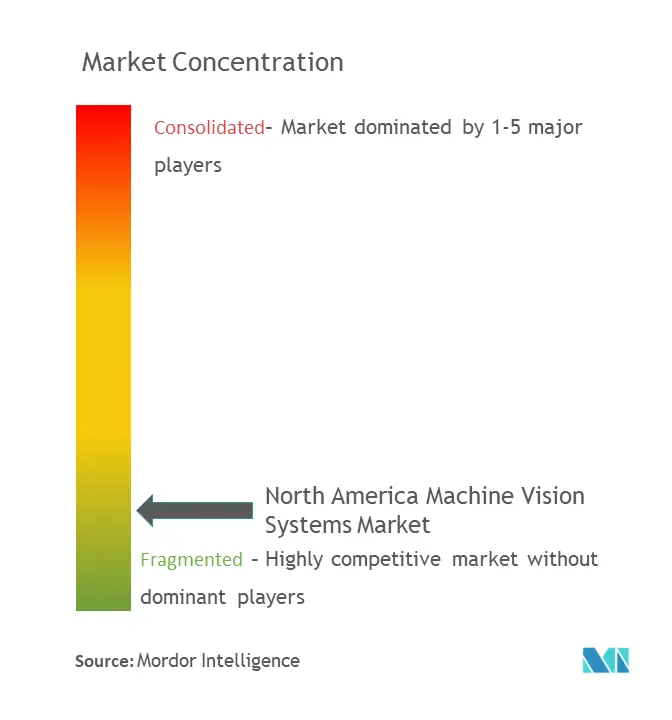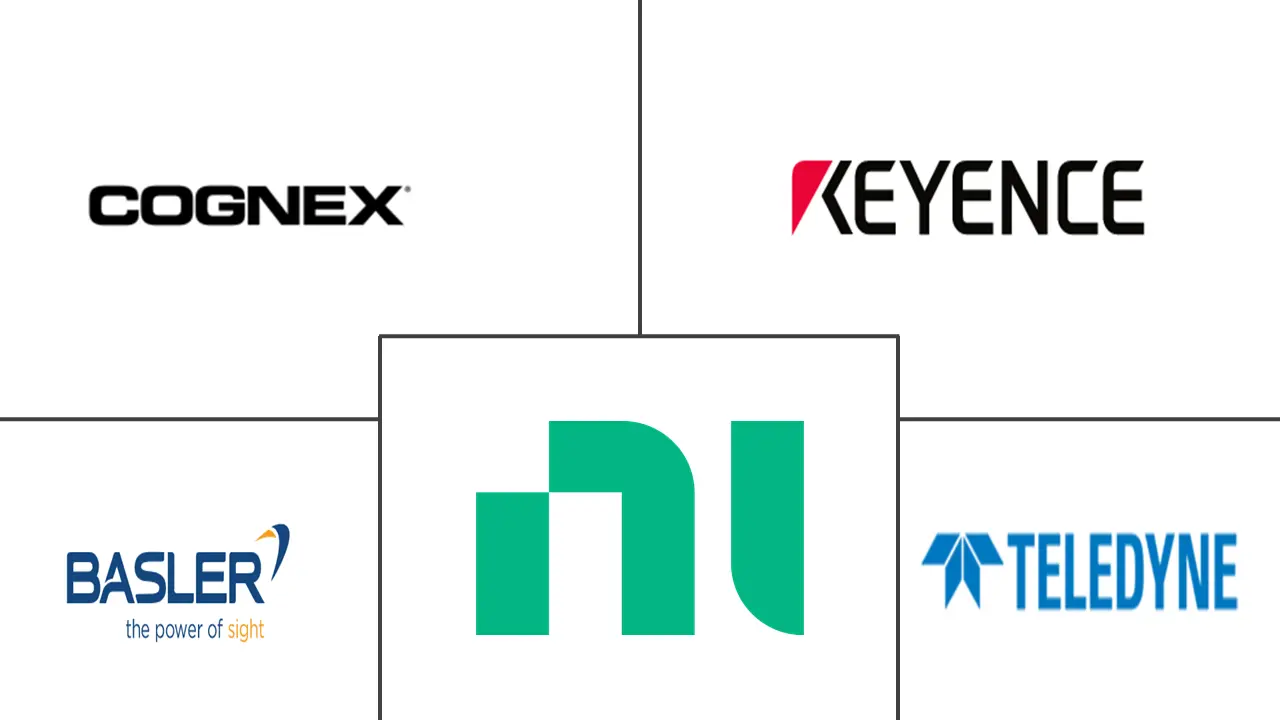
North America Machine Vision Systems Market Analysis by Mordor Intelligence
The North America Machine Vision Systems Market is expected to register a CAGR of 6.5% during the forecast period.
- North America is a sizable market for companies providing machine vision solutions. The regional market is expected to grow substantially over the forecast period, owing to the early introduction of automation in manufacturing and the presence of a significant number of market vendors of regional origin. According to the Association for Advancing Automation, sales of machine vision components and systems that offer vision intelligence to robots and other machines dropped in the first half of 2020; however, the market recovered in North America in the second half.
- Various innovations are also being seen in the market.For instance, recently, Canada-based iENSO launched an Ambarella-based platform ecosystem for embedded vision applications. AI vision processors for the Edge are provided by Ambarella Inc.Emerging machine vision technologies such as non-visible computational and 3D imaging combined with AI, machine learning, and deep learning enable machine vision to address an ever-expanding range of new applications.
- Machine vision systems have helped automation technologies save human workers from dangerous and dull jobs, from quality inspection to sorting products to guiding robots. Machine vision has even helped security systems find threats, driven self-driving cars, and inspected a lot of the world's infrastructure.
- The machine vision systems market is picking up speed as more changes are made in a number of areas and as more changes are made in its usual industries, such as automotive and industrial.
- For instance, in March 2022, Zebra Technologies announced its intent to acquire Matrox Imaging, a provider of platform-independent software, software development kits (SDKs), smart cameras, 3D sensors, vision controllers, input/output (I/O) cards, and frame grabbers that are used to capture, inspect, assess, and record data from industrial vision systems in factory automation, electronics and pharmaceutical packaging, semiconductor inspection, and more.
- The outbreak of COVID-19 significantly disrupted the supply chain and production in various industries of the studied market. However, the pandemic also expanded the scope of industrial automation and machine vision to enhance efficiency and address safety concerns. Partnerships, new product launches, and developments addressing COVID-19 were significant regional trends.
North America Machine Vision Systems Market Trends and Insights
Smart Camera-based Expected to Witness Significant Growth
- Innovative camera-based products are gaining popularity in industries due to the high rate of product innovation and expansion of existing applications in many end-user industries. Also, smart cameras have long eased the task of designing machine vision systems. The segment has witnessed continuous innovation in recent years, including models with larger image sensors, emerging embedded vision cameras that function as smart cameras, and new cameras capable of performing deep learning and AI tasks.
- Increased image sensor resolution in smart cameras, the integration of much faster processors or embedded vision cameras with MIPI interfaces, and the increasing availability of color and monochrome options in the market, which are also gaining popularity, especially after the COVID-19 outbreak, were all innovations in the market.
- Machine vision systems can track products, raw ingredients, and packaging throughout the production process and actively trace the paths to ensure high levels of quality and safety. For instance, according to the U.S. Census Bureau, the monthly retail sales from U.S. food and beverage stores were estimated at approximately USD 76.3 billion in March 2022. These statistics indicated an increase of about 10 percent from the previous month, February 2022.
- Matrox Imaging, based in Canada, recently introduced the Matrox Iris GTX model for edge IoT devices and the next generation of intelligent cameras. The company's Matrox Iris GTX smart cameras boast an Intel Atom x6000 embedded processor that can be used for both conventional machine vision operations and deep learning inference in the form of image classification and segmentation using Matrox Design Assistant X on-device software.

United States Expected to Witness Significant Market Share
- The country is at the forefront of automation and product innovation, providing a competitive advantage. Also, Microchip Technology Corporation introduced its Smart Embedded Vision Initiative. The ecosystem combines Microchip's low-power PolarFire FPGAs with high-speed imaging interfaces, intellectual property for image processing, and an expanded ecosystem of outside partnerships. This initiative aims to accelerate machine vision advancements for industrial, medical device, automotive, and aerospace applications. Such innovations by hardware and software vendors are expected to amplify market demand over the forecast period.
- Government initiatives, such as the Advanced Manufacturing Partnership, which is undertaken to make the industry, various universities, and the federal government invest in emerging automation technologies, are expected to increase the production of machine vision systems.
- Product innovation is still a key differentiator among market vendors.Also, many vendors are adopting partnership and acquisition strategies to gain a competitive advantage. Most hardware vendors have acquired strong software developers through partnerships or acquisitions to stay strong in the market.
- To keep production running and ensure higher quality, food and beverage manufacturers are turning to artificial intelligence (AI) to power machine vision inspection systems. AI's ability to learn and classify patterns lets machine vision technology find broken bottles, torn packaging, and other problems that can stop production and cause waste.
- Recently, a US-based company, Zebra Technologies Corporation, acquired graphical machine vision software developer Adaptive Vision and launched a new suite of machine vision smart cameras and fixed industrial scanners. With the acquisition of Adaptive Vision and its Adaptive Vision Studio and Library, Deep Learning Add-on, and WEAVER inference engine, Zebra Technologies expands its presence in the machine vision hardware and software marketplaces. The company is also introducing a new specialized track for industrial automation business partners, distributors, and systems integrators in its PartnerConnect program.

Competitive Landscape
The North America Machine Vision Systems Market is moderately competitive in nature. Product launches, high expenses on research and development, partnerships, and acquisitions are the prime growth strategies adopted by the companies in the region to sustain the intense competition. Key players in the market are Cognex Corporation, Keyence Corporation, Basler AG, National Instruments Corporation, Teledyne DALSA, Flir Systems Inc., Datalogic SpA, and Perceptron Inc.
In September 2022, Datalogic partnered with Prophesee SA, inventor of the most advanced neuromorphic vision systems, to announce the recent collaboration regarding the next generation of industrial products. According to the company, neuromorphic vision is a fascinating technology inspired by the behavior of the human biological system, precisely like neural networks. Prophesse has developed a breakthrough event-based vision approach to computer vision. This new vision category enables significant reductions in power, latency, and data processing requirements to reveal what was previously invisible to traditional frame-based sensors.
In March 2022, RG Group expands its partnership with machine vision supplier Cognex. Cognex Corporation designs, develops, manufactures, and markets a wide range of image-based products, all of which use artificial intelligence (AI) techniques that give them the human-like ability to make decisions based on what they see. Cognex products include machine vision systems and machine vision sensors. According to RG Group, the advanced vision system technology is a cornerstone of the company's solutions for clients, and Cognex continues to lead this quickly evolving field.
North America Machine Vision Systems Industry Leaders
Cognex Corporation
Keyence Corporation
Basler AG
National Instruments Corporation
Teledyne DALSA
- *Disclaimer: Major Players sorted in no particular order

Recent Industry Developments
- December 2022: Teledyne Flir Machine Vision introduced six new additions to the Teledyne FLIR Blackfly S GigE line of cameras that are BFS-PGE-80S5M/C-C featuring 8MP Sony IMX546: color and mono, BFS-PGE-120S6M/C-C featuring 12.3MP Sony IMX545: color and mono, and BFS-PGE-200S7M/C-C featuring 20MP Sony IMX541: color and mono. These models add to the wide range of GigE Vision-compliant cameras with an impressive lineup of sensors, resolutions, and powerful on-camera features.
- February 2022: Basler AG continues to expand its 3D imaging offering and adds an industrial-grade stereo camera series to its product portfolio. Robots equipped with Basler stereo cameras can perceive their surroundings in real-time. The five model variants are available at bare distances of 65 and 160 millimeters, each in monochrome and color versions. The cameras are equipped with a pre-installed, modular onboard software package suitable for typical robotics applications such as object recognition or bin picking. This helps drive the demand for machine vision systems.
North America Machine Vision Systems Market Report Scope
The Machine Vision System is the substitution of the human visual sense and judgment capabilities with a video camera and computer to perform an inspection task. It is the process of automatically taking pictures and analyzing them to get the information needed to control or evaluate a certain part or activity.
The North American machine vision systems market is segmented by component (hardware and software), by product (PC-based, smart camera-based), by end-user industry (food and beverage, healthcare and pharmaceutical, logistics and retail, automotive, electronics and semiconductors), and by country. The market sizes and forecasts are provided in terms of value (USD million) for all the above segments.
| Hardware | Vision Systems |
| Cameras | |
| Optics and Illumination Systems | |
| Frame Grabber | |
| Other Types of Hardware | |
| Software |
| PC-based |
| Smart Camera-based |
| Food and Beverage |
| Healthcare and Pharmaceutical |
| Logistic and Retail |
| Automotive |
| Electronics and Semiconductors |
| Other End-User Industries |
| United States |
| Canada |
| By Component | Hardware | Vision Systems |
| Cameras | ||
| Optics and Illumination Systems | ||
| Frame Grabber | ||
| Other Types of Hardware | ||
| Software | ||
| By Product | PC-based | |
| Smart Camera-based | ||
| By End-User Industry | Food and Beverage | |
| Healthcare and Pharmaceutical | ||
| Logistic and Retail | ||
| Automotive | ||
| Electronics and Semiconductors | ||
| Other End-User Industries | ||
| By Country | United States | |
| Canada |
Key Questions Answered in the Report
What is the current NA Machine Vision Systems Market size?
The NA Machine Vision Systems Market is projected to register a CAGR of 6.5% during the forecast period (2025-2030)
Who are the key players in NA Machine Vision Systems Market?
Cognex Corporation, Keyence Corporation, Basler AG, National Instruments Corporation and Teledyne DALSA are the major companies operating in the NA Machine Vision Systems Market.
What years does this NA Machine Vision Systems Market cover?
The report covers the NA Machine Vision Systems Market historical market size for years: 2019, 2020, 2021, 2022, 2023 and 2024. The report also forecasts the NA Machine Vision Systems Market size for years: 2025, 2026, 2027, 2028, 2029 and 2030.
Page last updated on:
North America Machine Vision Systems Market Report
Statistics for the 2025 North America Machine Vision Systems market share, size and revenue growth rate, created by Mordor Intelligence™ Industry Reports. North America Machine Vision Systems analysis includes a market forecast outlook for 2025 to 2030 and historical overview. Get a sample of this industry analysis as a free report PDF download.



